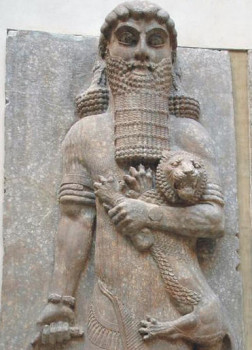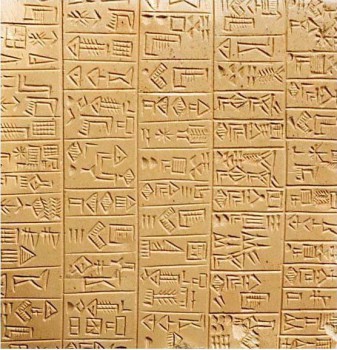Ancient Worlds: Gilgamesh and Enkidu

I like a good romance.
(Yes, we’re still talking Gilgamesh, I haven’t hit my head. Just give me a second. Haven’t we developed that kind of blogger/reader trust yet?)
In fact, I love a good romance. Give me a lady in a corset and a handsome young duke/earl/suitably wealthy gentleman/starving but really charming young artist, 300 pages and a stretch of time that my weesters are occupied elsewhere and I am all yours. I think the romance genre of fiction is underrated and, frankly, under-read by writers in many other genres.
But romance, or more precisely eros, has taken over fiction and fandom. Romantic relationships have become the primary relationship we see in our entertainment. Romantic tension is wedged into stories, often awkwardly. It’s often justified by seeking to appeal to a female demographic, as if women were incapable of liking stories without romance or that romance is the only relationship that we value. This is not only condescending, it’s exclusionary on a number of levels. And it is sad, because some of the greatest relationships in history were not romantic or familial, but friendships.
And the first great relationship we have recorded is just that. As we discussed last time, Gilgamesh has been making a royal pain of himself, and when his people pray for help, the gods respond by creating a man who will be his match. That man is Enkidu, and once the gods breathe life into him, they set him down in the wilderness.
The epic tells us that Enkidu is covered in hair, that he runs with the antelopes and eats grass with them. He is, in short, a wild animal. A hunter sees him and brings word of this Wild Man back to the king in Uruk. Enkidu is apparently not only living as an animal; he also destroys the hunters’ nets and prevents them from capturing any prey.
Gilgamesh’s answer to the problem? Get him a girl.
The Epic of Gilgamesh is not shy. In fact, it is explicit about what task the woman (Shamhat, a prostitute) is to perform to ensnare Enkidu.
“Go, trapper, and bring the harlot, Shamhat, with you
When the animals are drinking at the watering place
have her take off her robe and expose her sex
When he sees her he will draw near to her,
and his animals, who grew up in the wilderness, will be strange to him.”
Shamhat does just that, and after several days of drawing near to the her, Enkidu is no longer accepted by his animal friends.
 Most of the more familiar myths of this type are more coy. Adam and Eve eat forbidden fruit and are separated from both god and nature. The first humans in Greek myth are given fire, shortly followed by Pandora and her box of troubles. Here, the meaning is explicit: Shamhat, by initiating Enkidu into human sexuality, severs his relationship with wildness. She tames him, and in short teaches him how to eat bread and drink beer.
Most of the more familiar myths of this type are more coy. Adam and Eve eat forbidden fruit and are separated from both god and nature. The first humans in Greek myth are given fire, shortly followed by Pandora and her box of troubles. Here, the meaning is explicit: Shamhat, by initiating Enkidu into human sexuality, severs his relationship with wildness. She tames him, and in short teaches him how to eat bread and drink beer.
Shortly thereafter, Enkidu hears of Gilgamesh and his abuse of his people. He goes straight to Uruk and finds the king about to sleep with a virgin bride on her wedding night. Outraged, Enkidu blocks him from entering the bridal suite.
And then they fight. They wrestle up and down the city, shaking doorposts, rattling walls, and then…
the tablet breaks.
The heartache of literature maintained on pottery is that, well, it breaks. Pieces go missing. So we don’t know for certain who won the fight between Gilgamesh and Enkidu. We don’t know if it was a draw. But we do know that when the fight is over, they kiss and become best friends.
And literature was never the same again. They fight monsters together. They live together. They go on epic quests and insult goddesses together. That last bit was a terrible idea, though, and when Enkidu dies, it shatters Gilgamesh’s sense of himself and causes him to question the universe as he knows it.
This relationship between Gilgamesh and Enkidu is not only famous in its own right: it is believed to have inspired Homer’s portrayal of Achilles and Patroclus. They in turn inspired poets for the next four thousand years. While today a drama or book that focuses on the relationship between two men is unusual enough to have earned its own term (bromance, which I can’t decide if I love or loathe) pairs such as Sancho Panza and Don Quixote, Hamlet and Horatio, Sherlock and Watson once held a more central place in storytelling.
Now granted, if the Romans had written Star Wars, it would have centered on Han and Chewie, with Leia appearing in one scene with three lines. I’m certainly not asking for a rollback on storytelling conventions. But while I love romance, it’s only one aspect of the human experience.
Who are your favorite non-romantic pairings? Vlad and Loiosh from Steven Brust’s Taltos series top my list. (We can include non-humans, right?) Babylon 5’s Sheridan and Ivanova are up there as well. But I’m always looking for new ones. So hit me up!
Elric and Stormbringer? Well, OK, maybe not …
I am deeply ashamed to admit I have not read the Elric books. I know, I know, I’m a terrible geek. f
The Hobbit has three:
Gimli and Legolas
Merry and Pippin
Frodo and Sam.
Actually, I thought Babylon 5’s Londo and G’kar are a much better example of this type of relationship than Sheridan and Ivanova. Bitter enemies who become … well, slightly less bitter over five years.
Druss the Legend and Sieben the Poet, from David Gemmel.
John Conroe’s Demon Accord series features a series of friendships with a fair degree of complexity.
And I really like the friendship between Nanny Ogg and Esme Weatherwax (I know, a friendship between two women, in a fantasy book, whatever next)
From Martha Wells’s Fall of Ile-Rien series, Ilias and Giliead. Okay, they’re sort of brothers but also sort of not.